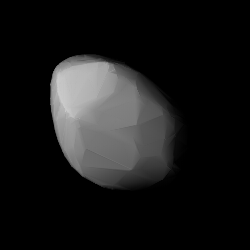 Shape model of Toro from its lightcurve | |
| Discovery [1] | |
|---|---|
| Discovered by | C. A. Wirtanen |
| Discovery site | Lick Obs. |
| Discovery date | 17 July 1948 |
| Designations | |
| (1685) Toro | |
Named after | Betulia Toro Herrick (wife Samuel Herrick) [2] |
| 1948 OA | |
| NEO · Apollo [1] [3] Mars-crosser | |
| Orbital characteristics [1] | |
| Epoch 5 May 2025 (JD 2460800.5) | |
| Uncertainty parameter 0 | |
| Observation arc | 76.75 yr (28,032 days) |
| Aphelion | 1.9643 AU |
| Perihelion | 0.7714 AU |
| 1.3679 AU | |
| Eccentricity | 0.4360 |
| 1.60 yr (584 days) | |
| 319.462° | |
| Inclination | 9.382° |
| 274.208° | |
| 127.279° | |
| Earth MOID | 0.0510 AU ·19.9 LD |
| Physical characteristics | |
| 3.810±0.049 km [4] 4.1 km [5] 3.5+0.3 −0.4 km [6] | |
| 10.185±0.003 h [7] 10.1862±0.0006 h [8] 10.191±0.005 h [9] 10.195 h [10] 10.19540 h [11] 10.196 h [12] 10.199±0.003 h [13] 10.1995±0.0004 h [14] 10.203±0.003 h [15] 10.197826±0.000002 h [6] | |
| 0.247±0.049 [4] 0.29 [5] 0.38±0.33 [16] | |
| 13.90 [5] [18] ·14.02±1.11 [19] ·14.28 [1] ·14.23 [4] | |
1685 Toro (prov. designation: 1948 OA) is an asteroid and near-Earth object of the Apollo group on an eccentric orbit. It was discovered on 17 July 1948, by American astronomer Carl Wirtanen at Lick Observatory on Mount Hamilton, California. [3] [20] The stony S-type asteroid has a rotation period of 10.2 hours and measures approximately 4 kilometers (2.5 miles) in diameter. It is named for Betulia Toro Herrick, wife of astronomer Samuel Herrick. [2]